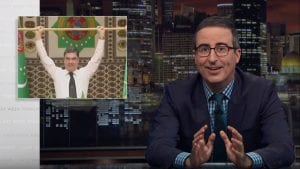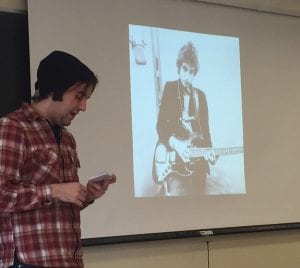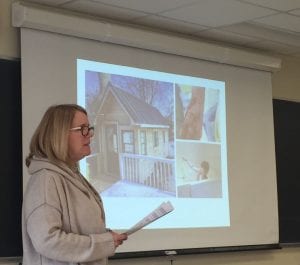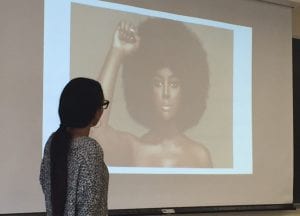“Tell all the truth but tell it slant.” Emily Dickinson’s circumlocutory anthem for poetic truth haunted my English course last semester. Using Dickinson’s verse as a frame along with a contemporary reading of Herman Melville’s Bartleby–perhaps best illustrated in this short film by directors Laura Naylor and Kristen Kee–we consistently asked how truth becomes socially constructed based on our current digital society. Does the medium become the message ? How can we equip ourselves to determine the truths of our world through a culture continually converging and merging media?
I was lucky enough to teach EGL. 309 last semester, an interdisciplinary English course which I shaped based on my own research interests. Thematically subtitled “Media Literacy and Literary Identity,” the purpose of the course was for students to focus on how we communicate in our digital world. In fun ways for me, I was able to incorporate some literacy initiatives and experiential learning techniques that I have created in my past along with some of my doctoral training from SBU.
I asked students to engage with a wide-range of media in the course while asking them to reflect on how they personally and culturally “read” when confronted with certain visual, sonic, and textual forms. With a little help from M.C. Escher’s “Drawing Hands,” we discussed how literacy in our culture requires our constant, active engagement: we all have a role in creating truth, even if, as Dickinson reminds us, we tell it slant.
In the course, we read some self-reflexive literary texts that critique the ways in which  various types of media manifest in the literary imagination. These include Claudia Rankine’s imagetext Citizen, Michael Cunningham’s poetic novel Specimen Days, Jennifer Egan’s musical manifesto A Visit From the Goon Squad, Marjane Satrapi’s graphic novel Pesepolis, among others. We also analyzed television culture through Peter Weir’s The Truman Show, twitter culture through Teju Cole, and information culture through Michael Wesch’s In/formation Revolution. Here’s a copy of the syllabus if you’re interested in checking out the sequence of the course.
various types of media manifest in the literary imagination. These include Claudia Rankine’s imagetext Citizen, Michael Cunningham’s poetic novel Specimen Days, Jennifer Egan’s musical manifesto A Visit From the Goon Squad, Marjane Satrapi’s graphic novel Pesepolis, among others. We also analyzed television culture through Peter Weir’s The Truman Show, twitter culture through Teju Cole, and information culture through Michael Wesch’s In/formation Revolution. Here’s a copy of the syllabus if you’re interested in checking out the sequence of the course.
I knew from the start of the semester that I wanted to incorporate a presentation in order for students to personally engage with some of the themes of the class. Aside from various types of written, visual, and digital assessments, I really wanted students to create Pecha Kucha presentations. I went to a dynamic workshop put on by Professor Nicole Galante at the beginning of the semester which inspired me! So, following some of her directives, and with some help from Pecha Kucha 20×20, I created an assignment that allowed students to engage with one issue associated with any type of media representation that relates to them personally and culturally. Students were required to introduce the topic and make an argument using a combination of words and images that follows the set of guidelines required by the Pecha-Kucha form.
Some Guidelines
In case you don’t know, PechaKucha (Japanese for chit-chat ぺちゃくちゃ ) is a presentation style in which 20 slides are shown for 20 seconds each (6 minutes and 40 seconds in total). Each slide features images, not talking point bullets or sentences. I did allow students to place a powerful phrase with an image if necessary, but I emphasized that words should not dominate the screen. Words, really, should be reserved for speaking. Since the presentation itself promotes creativity, I encouraged students to weave a brief story in the slides to stress the most significant aspects of their topics. Together we watched some examples found here, and I provided some tutorials to set up their presentations, like this example here. We even watched a Pecha Kucha on Pecha Kucha! I also graded students based on some of the parameters found in this rubric here.
Students presented their projects during the final three days of the class. Their presentations covered a range of topics related to the changing representations of literacy in digital culture. And in all, students were given the ability to really focus on their presentation skills. This was especially important to me. I’ve learned the hard way in my own educational life that students who perform well often grab the attention of professors or educators, and well, I wasn’t about to let some of my bright (but quiet) students be dismissed because they lack some of those skills naturally. Everyone speaks and everyone gains from it. And the formal/informal style of this type of presentation helped create the right type of nervous tension in the classroom.

Slide from Evan Donnellan’s post on horror films. Pictured–an image from Jordan Peele’s Get Out (2017).
Some of the topics covered include Sana Rahman’s sociopolitical critique of space in pop culture, Sean McDonough’s representation of the posthuman, Holly Jones’s evaluation of Instagram poetry, Elizabeth Johnson’s analysis of intergenerational conflict on FaceBook, Lazaro Riviera and Emily Reilly’s presentations on the changing face of family sitcoms, Evan Donellan’s analysis of the genre of horror films–old and new.
With their permission, I’ve included some photos to illustrate a few highlights from student presentations, but I wish I could share them all. While I realize that Pecha Kucha is a presentation form that many are pretty familiar with, I had yet to engage with it in my own teaching. So, overall, I’m pretty happy with the way things turned out. It’s been so gratifying working with this group of students, and they’ve taught me quite a bit this semester. Since this is the last “live” course I’m teaching for SBU’s English Department, these students have reminded me how much I’ll miss the student body at Stony Brook.
Getting the Most Out of Pecha Kucha
Here are some overall tips to create a Pecha Kucha effectively:
- Avoid writing out a script for your narration. Write a simple outline for the big
ideas of each slide. The best situation is when you know your topic so well that you don’t even need an outline. Use the outline for planning purposes.
- Practice the presentation repeatedly. If you are new to presenting, use the tool/rehearse timings in PowerPoint. The general word count is dependent upon your own pacing, but no more than 60 words per slide is a good start.
-
You can also record your narrations within PowerPoint for each slide. But be sure not to “save timings” when you’re done, for that will negate the automatic 20 seconds you put in place previously.
- Keep it simple and create a story arc. Figure out the points you want to emphasize and make sure to have transitions throughout.
- Remember the visuals should be engaging and simple.









Thank you for sharing this fascinating article about Pecha Kucha: The Art of Chit Chat, I was looking for such a post. I am also a student Actually,
I just needed some help, so a friend of mine asked me for help with the best dissertation writing services free in the meantime, which is very good I will also share this post with my friends.